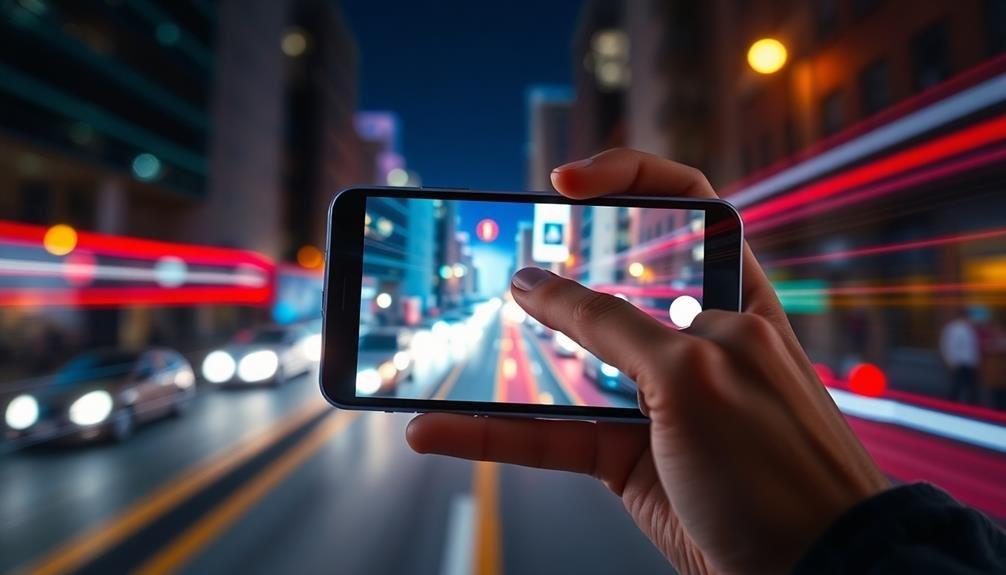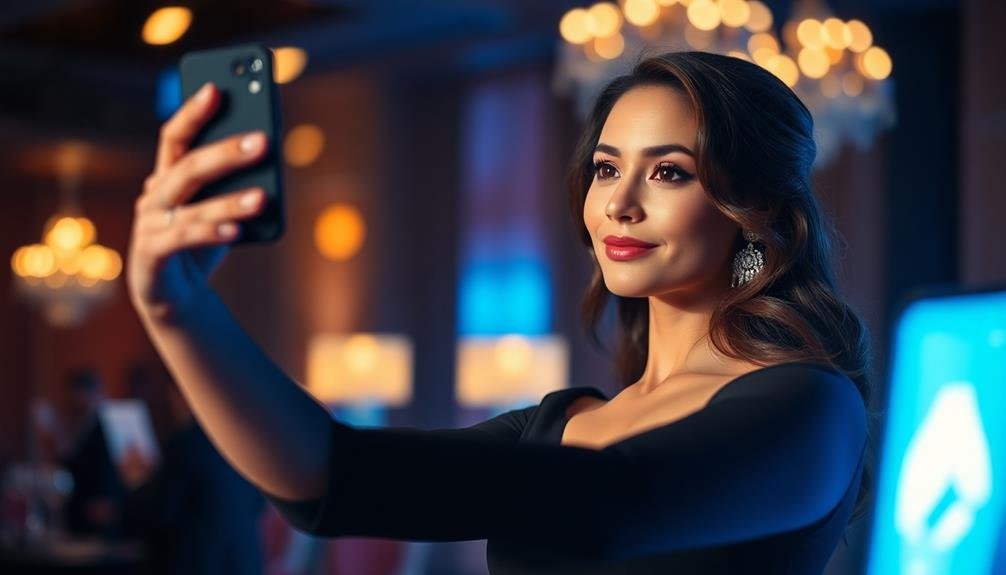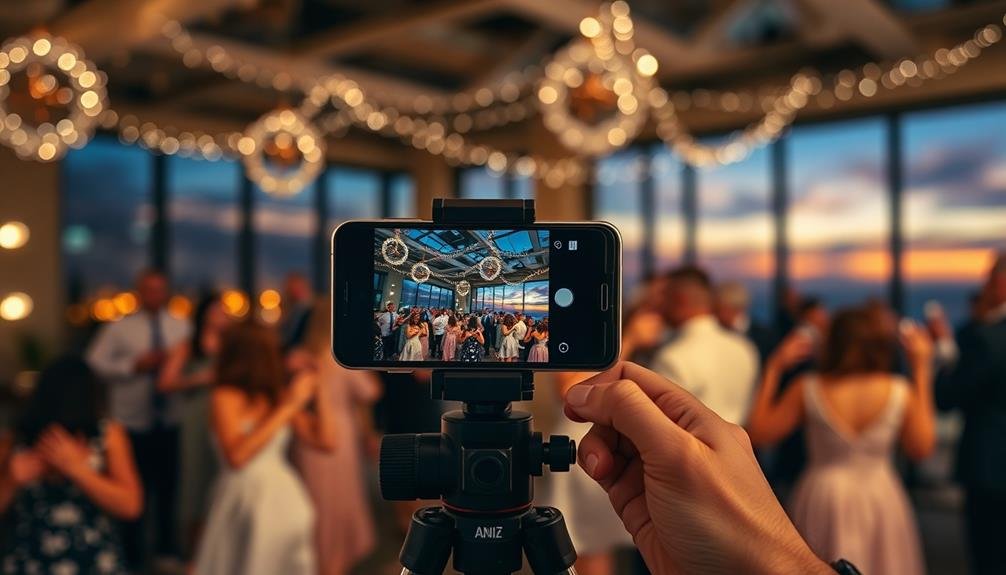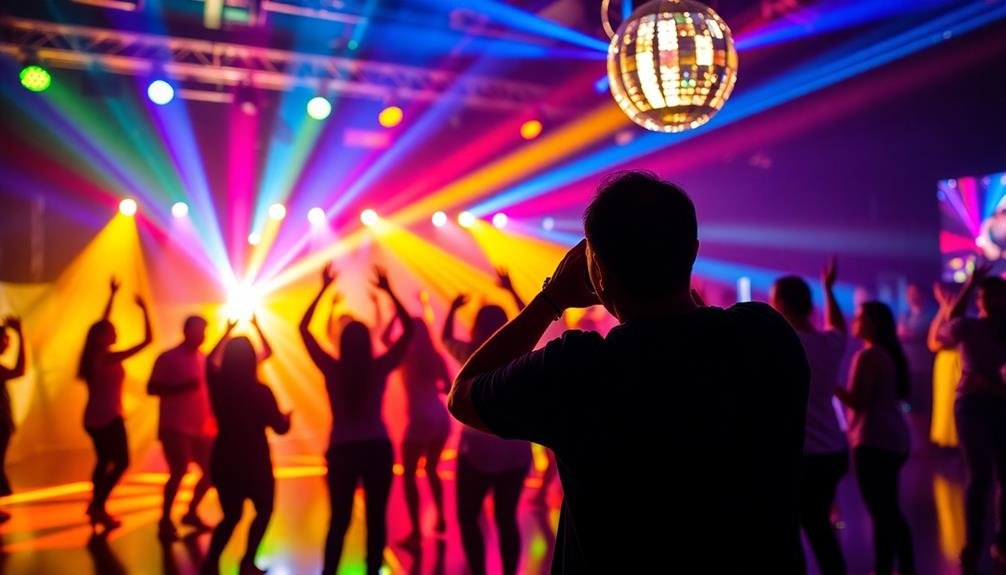To create motion blur on your phone, start by using Long Exposure mode in your camera app settings. Next, experiment with panning techniques to emphasize moving subjects while blurring the background. Adjust your shutter speed settings for ideal blur effects, using slower speeds for more dramatic results. Utilize motion blur apps for automated approaches and additional editing tools. Finally, practice capturing moving subjects effectively by considering their speed and experimenting with angles. These techniques will help you transform ordinary scenes into dynamic, artistic images. Mastering these tips will open up a world of creative possibilities for your smartphone photography.
Use Long Exposure Mode

Smartphones have come a long way in their photography capabilities, and many now offer a Long Exposure mode that's perfect for creating motion blur. This feature allows you to capture movement over time, resulting in a dreamy, artistic effect.
To use Long Exposure mode, first locate it in your camera app's settings or modes. It's often found alongside other advanced features like HDR or Night mode. Once activated, you'll need to stabilize your phone to prevent unwanted camera shake. Use a tripod or prop your device against a stable surface.
Choose your subject carefully. Moving water, traffic lights, or bustling crowds work well for motion blur. Frame your shot and guarantee that there's a mix of stationary and moving elements for contrast.
Adjust the exposure time based on the speed of your subject and the desired effect. Slower movements require longer exposures. Experiment with different shutter speeds to achieve varying levels of blur. Start with a few seconds and increase as needed.
Experiment With Panning Techniques

With panning techniques, you can create a different type of motion blur that emphasizes your moving subject while blurring the background. To master this technique, start by choosing a subject that's moving horizontally across your frame. Bicyclists, cars, or runners work well for this effect.
Set your phone's camera to shutter priority mode if available, or use a third-party app that allows manual shutter speed control. Select a slower shutter speed, typically between 1/15 and 1/30 of a second, depending on your subject's speed.
As your subject moves, follow its motion smoothly with your phone, keeping it in the same position within your frame. When you press the shutter, continue the panning motion even after you've taken the shot. This follow-through is essential for achieving a smooth blur.
Practice this technique repeatedly, adjusting your shutter speed and panning speed until you find the right balance. Remember, the key is to keep your subject sharp while blurring the background.
Experiment with different subjects and speeds to refine your skills and create striking motion blur images that convey a sense of movement and energy.
Adjust Shutter Speed Settings

Now that you've explored panning techniques, let's focus on adjusting shutter speed settings to enhance your motion blur photography. Many modern smartphones offer manual camera controls, including shutter speed adjustment.
To create motion blur, you'll want to use slower shutter speeds, typically between 1/15 and 1/2 of a second. Start by accessing your phone's pro or manual camera mode. Look for the shutter speed setting, often represented by a fraction (e.g., 1/60).
Experiment with different speeds to achieve your desired effect. Remember, slower speeds allow more motion blur but increase the risk of camera shake. To counteract unwanted blur, use a tripod or stabilize your phone against a solid surface.
If your subject is moving quickly, you might need a faster shutter speed to capture some sharpness while still showing motion. When shooting in low light, be aware that slower shutter speeds will result in brighter images.
Adjust your ISO and aperture settings accordingly to maintain proper exposure. Don't be afraid to take multiple shots with varying shutter speeds to find the perfect balance between blur and clarity for your specific scene.
Utilize Motion Blur Apps

For those who prefer a more automated approach, motion blur apps offer a convenient alternative to manual camera settings. These apps can help you create stunning motion blur effects with just a few taps on your screen.
To get started, search for "motion blur" or "long exposure" apps in your device's app store. Popular options include Slow Shutter Cam, Camera FV-5, and ProCam. Once you've installed an app, open it and explore its features.
Most apps allow you to adjust the blur intensity, shutter speed, and other parameters to achieve your desired effect. When using a motion blur app, keep your phone steady or use a tripod for the best results.
Experiment with different subjects and movements to create various effects. You can capture light trails from passing cars, smooth out flowing water, or add a sense of motion to still objects.
Don't forget to experiment with the app's post-processing tools. Many apps offer additional features like adjusting contrast, brightness, and color balance to enhance your motion blur images.
With practice, you'll be able to create professional-looking motion blur photos right from your smartphone.
Capture Moving Subjects Effectively

Mastering the art of capturing moving subjects is key for creating compelling motion blur photos on your phone. To achieve this effect, you'll need to take into account your subject's speed and direction. For slower subjects, like people walking, use a shutter speed of 1/15 to 1/30 second. Faster subjects, like cars or sports activities, require faster shutter speeds of 1/60 to 1/125 second.
Position yourself strategically to capture the subject's movement. Try panning, where you follow the subject with your camera as it moves. This technique keeps the subject sharp while blurring the background. Alternatively, keep your phone still to blur the moving subject against a sharp background.
Experiment with different angles and perspectives to add interest to your shots. Reflect on shooting from low angles or incorporating foreground elements to create depth.
| Emotion | Slow Subjects | Fast Subjects |
|---|---|---|
| Calm | Flowing water | Clouds |
| Energy | Walking people | Sports action |
| Mystery | Swaying trees | City traffic |
| Wonder | Ferris wheel | Fireworks |
Remember to use burst mode or continuous shooting to increase your chances of capturing the perfect moment. With practice, you'll develop an intuitive sense for timing and framing that'll elevate your motion blur photography.
Frequently Asked Questions
Can Motion Blur Be Added to Existing Photos After They're Taken?
Yes, you can add motion blur to existing photos after they're taken. You'll need photo editing software or apps with blur tools. Apply the effect selectively to create the illusion of movement in your static images.
How Does Lighting Affect Motion Blur in Smartphone Photography?
Lighting greatly impacts motion blur in your smartphone photos. In low light, you'll need slower shutter speeds, increasing blur. Bright conditions allow faster shutter speeds, reducing blur. You can manipulate this effect by adjusting exposure settings on your phone.
Are Tripods Necessary for Creating Motion Blur on Smartphones?
You don't always need a tripod for motion blur on smartphones. While they're helpful, you can stabilize your phone against objects or use your body. However, for longer exposures, a tripod's essential to avoid camera shake.
What's the Difference Between Motion Blur and Focus Blur?
You'll notice motion blur captures movement over time, creating streaks or trails. Focus blur, on the other hand, is when you've got a sharp subject against a blurry background. They're different effects achieved through distinct techniques.
Can Motion Blur Be Achieved When Photographing Stationary Objects?
Yes, you can create motion blur with stationary objects. You'll need to move your camera during a long exposure shot. Try panning or zooming while capturing the image to achieve the desired blur effect.
In Summary
You've now got the tools to capture stunning motion blur shots right on your phone. Don't be afraid to experiment with different techniques and settings. Practice makes perfect, so keep trying until you achieve the desired effect. Remember, motion blur can add a dynamic, artistic touch to your photos. Whether you're shooting traffic, sports, or nature, these tips will help you create eye-catching images that stand out from the crowd. Get out there and start blurring!





Leave a Reply